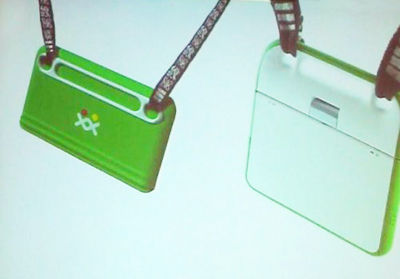XO-2: Difference between revisions
m (line spacing, moved image) |
|||
| Line 14: | Line 14: | ||
* 1 watt power consumption |
* 1 watt power consumption |
||
* Price of US$75 to large educational buyers |
* Price of US$75 to large educational buyers |
||
Anyone at OLPC touch type???? Apparently not, with a membrane keyboard. Let's take kids back to the 1960's so they can grow up like the OLPC design team, that didn't take touch typing in high school. Are you guys crazy???? |
|||
=More detailed hardware ideas= |
=More detailed hardware ideas= |
||
Revision as of 00:51, 5 July 2008
XO-2 Laptop Design
On May 21, 2008, at an OLPC Country Meeting, design studies of a next-generation OLPC laptop (the XOXO or XO-2) were shown to attendees and to the world press.
Other detailed goals include:
- Dual 16x9 proportioned sunlight-readable touch screens
- Keyboard and touchpad both replaced by touch screens
- Physically smaller than XO-1; size and weight more like a book
- 1 watt power consumption
- Price of US$75 to large educational buyers
Anyone at OLPC touch type???? Apparently not, with a membrane keyboard. Let's take kids back to the 1960's so they can grow up like the OLPC design team, that didn't take touch typing in high school. Are you guys crazy????
More detailed hardware ideas
These are from people who are not on the hardware design team, so are best described as "wild guesses":
- Speakers and camera almost certainly: Record is one of the most-used applications on the XO-1. (The kids in Peru asked for a flash; there are safety issues with that, though.)
- Mesh networking, yes. Not connected with USB! (since this is a big part of our suspend/resume troubles ATM.)
- Fold-out antennae: these were difficult to manufacture with repeatable characteristics. On the other hand, they became an iconic XO feature.
Some other features that have been discussed
- GPS (unknown whether this will be able to make the cost budget)
- Accelerometer (so that rotation is magic, not manual)
- Light sensor (so backlight level can be automatic for better power savings)
- Hinge-angle sensor (detect 'tablet mode' as well as 'closed')
- Hardware-protected RTC (bitfrost desiderata)
- Better protection for firmware FLASH, to avoid the possibility of bricking a machine if the power is removed at the wrong time.
- More open hardware design (schematic) -- this is really a contractual issue with the manufacturer
- More open software: we may not need an EC, and if we do we may be able to ensure its code is open. We may change the wireless device, and/or be able to switch to open firmware for it.
- Gigabit Ethernet port (for reliable networking among hundreds of laptops in a school)
- Power over Ethernet (so laptops charge while networked, in school)
- Should it have USB? USB is the worst part of the XO-1's power management architecture. But USB is also the main expansion port, to reflash, to add a keyboard or mouse, to get Ethernet, to power custom peripherals like medical monitors.
- Should it have an SD slot? It definitely needs a nonvolatile memory expansion strategy, and SD is reasonable. 8-bit-wide SD/MMC is twice as fast as the 4-bit-wide one in the XO-1.
- Stereo audio in?
- Stereo audio out?
- Integrated speakers? (They can also perhaps provide tactile feedback for the virtual keyboard, if designed to do so.)
- Stylus and stylus slot? Virtually every other touchscreen computer has one, for picking or writing with a stroke smaller than a blunt fingertip.
- Processor: not yet selected. It will almost certainly be a highly integrated System-on-Chip, so merely picking an architecture like "x86" or "ARM" isn't sufficient. Suggestions from the audience: XXX
- Battery? LiFePO4 seems to work pretty well in the XO-1. If OLPC could design a "standard" small LiFePO4 battery form factor, like a replacement for the AA that has an interruption-proof connector suitable for computers, it could become a standard worldwide in all sorts of electronics, such as flashlights. This would certainly help with spares!
- Software radio receiver? AM and shortwave, maybe FM, maybe analog TV, are probably doable for pennies. Kids can learn about radio and signal processing -- and have mass communication (AM radio) receivers.
- Software radio transceiver? An open WiFI chip would probably suffice for this.
For More Information
See also: All TRAC tickets marked "gen2" at dev.laptop.org. For example, #836 (Gen 2 wishlist).
Software development plans
Linux, evolving forward from the current XO software.
Jim Gettys recommends looking at Peter Hutterer's videos on YouTube (search for "mpx"). That shows the practicality of touch based and multi-user based interfaces in Linux.

